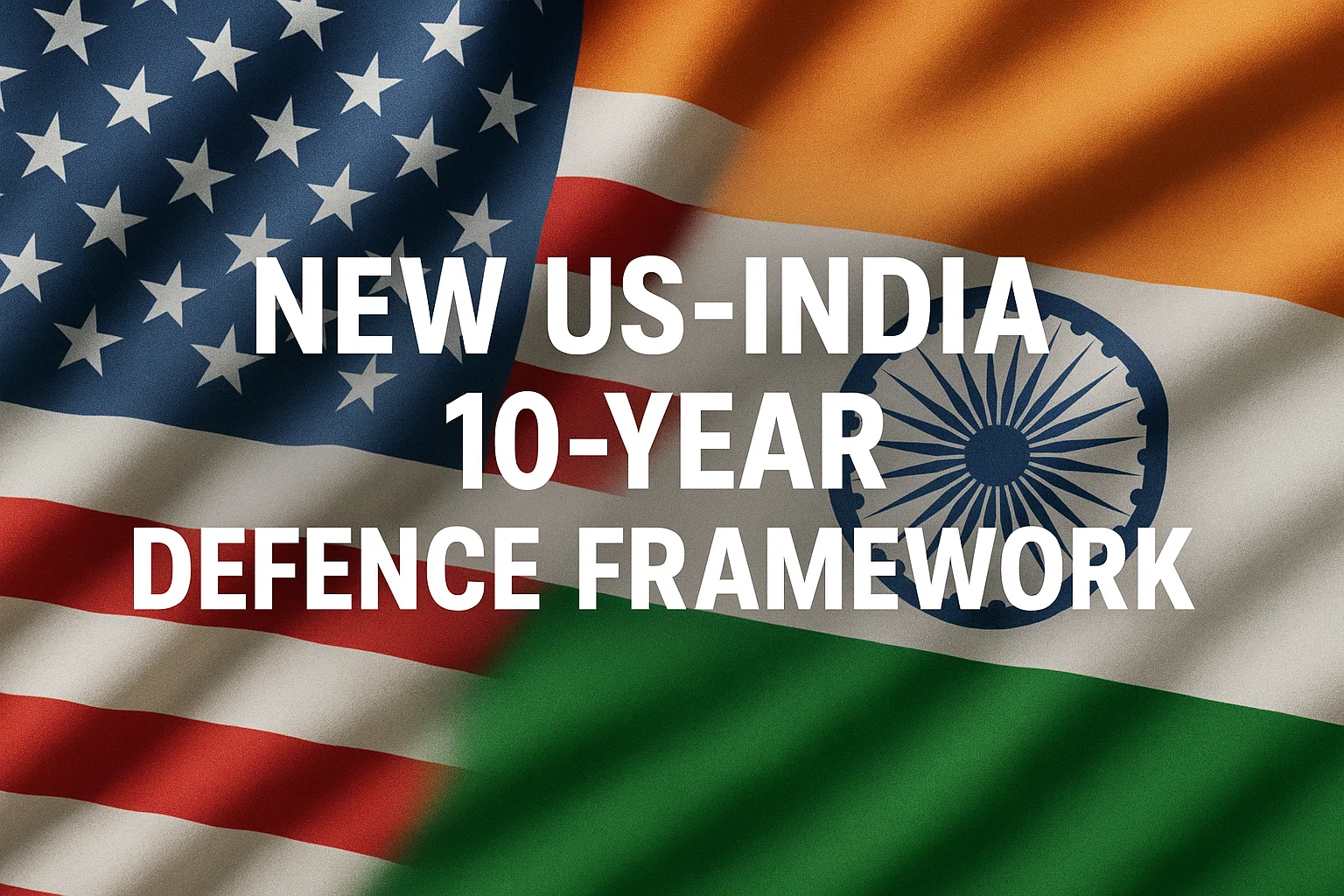New US-India 10-Year Defence Framework
Explore the significance of the New US-India 10-Year Defence Framework—its objectives, evolution, strategic benefits, challenges, and impact on India’s defence modernisation and Indo-Pacific security architecture. A must-read for UPSC aspirants studying international relations and defence policy.
New US-India 10-Year Defence Framework | Strategic Partnership & Military Cooperation
Context:
Amidst ongoing negotiations on trade and differences over India’s energy imports from Russia, India and the United States have signed a significant 10-year Framework for their Major Defence Partnership.

What is the recent defence framework about?
The recent “Framework for the US-India Major Defence Partnership” is a 10-year agreement designed to provide an overarching vision and policy direction to deepen and expand defence cooperation. It is not a treaty for specific arms purchases, but a strategic roadmap intended to:
- Provide policy direction across the entire spectrum of the defence relationship.
- Ensure stability and long-term commitment beyond individual government tenures.
- Usher in a new era of stronger ties, transforming the partnership over the next decade through enhanced coordination, information sharing, and technological cooperation.
How has the India-US defence partnership evolved over time?
The partnership has evolved from estrangement during the Cold War to a comprehensive strategic embrace:
- Foundational Pacts (2013-2015): The journey was charted by the 2013 Joint Declaration on Defence Cooperation and the 2015 Framework for the US-India Defence Relationship.
- Enabling Agreements (2016-2020): This period saw the signing of four foundational “enabling” agreements:
- LEMOA (2016): Logistics Exchange Memorandum of Agreement for mutual use of military facilities.
- COMCASA (2018): Communications Compatibility and Security Agreement for secure, encrypted communications.
- BECA (2020): Basic Exchange and Cooperation Agreement for sharing of geospatial intelligence.
- Recent Milestones (2024): Signing of the Security of Supply Arrangement (SOSA) and an agreement on Liaison Officers, alongside continued joint exercises like Yudh Abhyas.
Why does the US need India for a global defence arrangement?
The US views India as an indispensable partner for its global and regional strategic objectives for several reasons:
- Counterbalancing China: India is a pivotal, resident power in the Indo-Pacific, crucial for deterring Chinese assertiveness and ensuring a “free and open” regional order.
- Strategic Geography: India’s location in the Indian Ocean is vital for sea lane security and power projection.
- Shared Democratic Values: As the world’s largest democracy, India is a natural partner in upholding a rules-based international order, contrasting with the authoritarian models of US rivals.
- Burden Sharing: A capable Indian military acts as a net security provider in the region, reducing the sole burden on the US.
How does such a partnership help India?
The partnership offers India significant strategic, military, and technological benefits:
- Military Modernisation: Access to cutting-edge American military technology (e.g., MH-60R helicopters, MQ-9B drones, jet engine co-production) to narrow the capability gap with adversaries.
- Strategic Autonomy with Alignment: While maintaining strategic autonomy, the partnership strengthens India’s hand against security threats, particularly from China and Pakistan.
- Boosting Domestic Defence Industry: Initiatives like the GE jet engine deal and other potential co-development and co-production projects under the US-India Defence Industrial Cooperation roadmap are key to the “Make in India” initiative.
- Enhanced Interoperability: Joint exercises and secure communications allow the Indian military to operate effectively with US and other allied forces.
What are the major challenges associated with it?
Despite the progress, the partnership faces significant hurdles:
- Bureaucratic and Regulatory Hurdles: Differing procurement processes, US export control regulations (ITAR), and India’s slow decision-making can delay projects.
- Strategic Divergence: Differences persist on issues like India’s relationship with Russia (including energy and legacy defence purchases) and the Iran policy, which can cause friction.
- Trade and Economic Disputes: Unresolved trade issues, such as the recent US tariffs on Indian steel and aluminium, can spill over to affect the strategic relationship.
- Technology Transfer Hesitancy: While improving, the US has historically been reluctant to share core technologies, a key Indian demand for true self-reliance.
Subscribe to our Youtube Channel for more Valuable Content – TheStudyias
Download the App to Subscribe to our Courses – Thestudyias
The Source’s Authority and Ownership of the Article is Claimed By THE STUDY IAS BY MANIKANT SINGH





